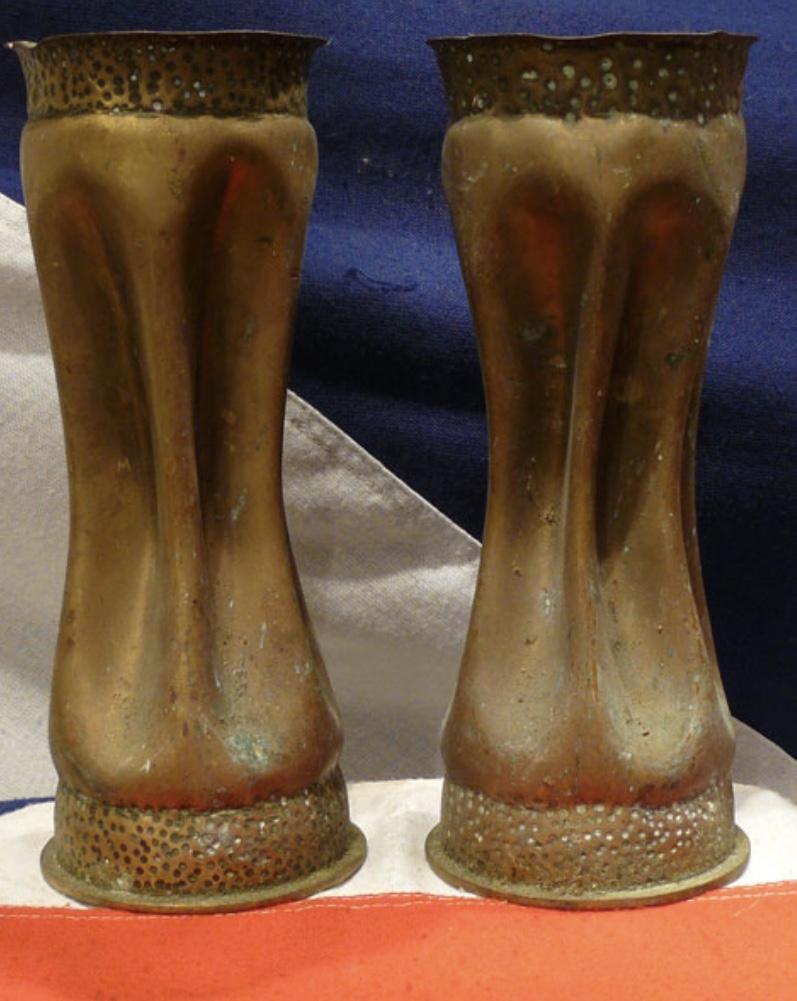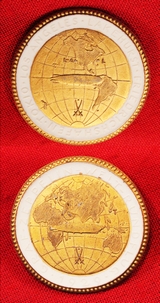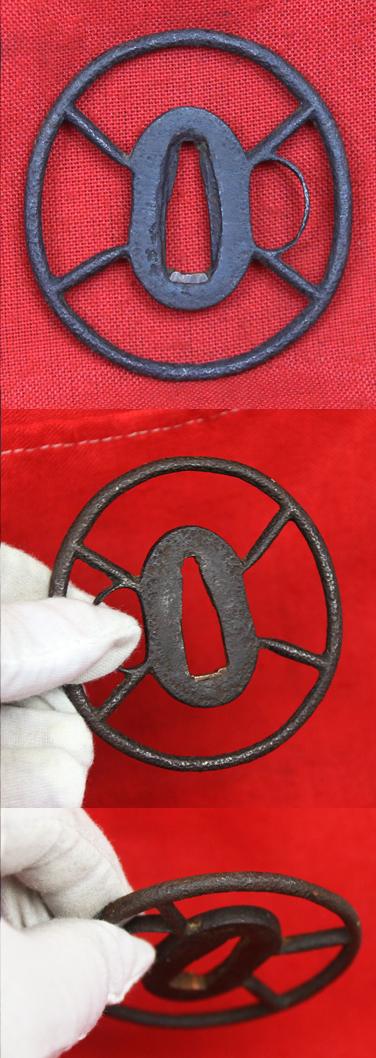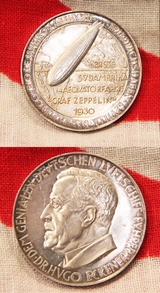A Very Rare Long Distance Flight Medal, Major von Parseval 1909
GERMANY. Medals by Karl Goetz. Silver medal 1909.. On the major's long-distance airship trips, e.g. D. August of Parseval. Half-length portrait to the left. rev. Eagle with outstretched wings on airship. by K.Goetz . Bayer Huptmunzamt Feinsilber.
Designed by world renown medalist Karl Goetz [1875 - 1950]
Very Rare silver medal, for the flight of 12th to 19th October, 1909. Long-distance voyages of the Parseval airships. Half-length portrait of the airship designer A. Parseval to the left / eagle stands with outstretched wings on the bow of the airship, below water surface, above right inscription. Hallmark: feinsilber BAYER. MAIN MINT OFFICE. it was awarded in two grades silver and bronze, this, the silver is an incredibly rare antique aviation medal from the earliest days of airships. August von Parseval (5 February 1861, in Frankenthal (Pfalz) – 22 February 1942, in Berlin) was a German airship designer.
As a boy, Von Parseval attended the Royal Bavarian Pagenkorps in Munich from 1873 to 1878, where he took the Fähnrichexamen (cadet exams). He then joined the Royal Bavarian 3rd Infantry Regiment Prinz Carl von Bayern. An autodidact, he busied himself with the problems of aeronautics. In the garrison town of Augsburg he came into contact with August Riedinger and also came to know his later partner Rudolf Hans Bartsch von Sigsfeld, with whom he developed Drachenballons: balloons used by the military for observation.
In 1901 Parseval and Sigsfeld began building a dirigible airship. After Sigsfeld's death during a free balloon landing in 1902, the work was interrupted until 1905.
By 1905, thanks to improvements in motor design, an appropriate engine was now available. His designs were licensed to the British Vickers company. Up to the end of the First World War, 22 Parseval airships (both non-rigid (blimps) and semi-rigid (with keels)) were built. In the late twenties and early thirties, four more semi-rigid airships were built in accordance with the "Parseval-Naatz principle". read more
645.00 GBP
A Good WW1 14/15 Star 'South African' Trio With Transvaal Scottish Badge
8th Infantry, and further badges. All medals named. He served in the 7th and 8th Infantry. British TOE in April, 1916:
1st Division (Major General AR Hoskins)
1st East African Brigade- 2nd Loyal North Lancs, 2nd Rhodesia Regiment, 130th Baluchis, 3rd Kashmir Rifles/3rd KAR (Composite Batt)
2nd East Afican Brigade- 25th Royal Fusiliers, 29th Punjabis, 129th Baluchis, 40th Pathans
Divisional Troops- 17th Indian Cavalry (one squadron), East African Mounted Rifles, King's African Rifles Mounted Infantry (one company), East Africa Pioneer Corps (Mounted Section), 27th Mountain Battery, 5th Battery South African Field Artillery, # 6 Battery (four 12 pdrs manned by 2nd LNL), # 7 Battery (four 15 pdrs), 38th Howitzer Brigade (one section of two 5" Howitzers), Willoughby's Armored Car Battery, 2nd LNL Machine-gun Company.
2nd East African Division (Major General J Van Deventer)
1st South African Mounted Brigade- 1st SA Horse, 2nd SA Horse, 3rd SA Horse, 8th SA Horse (forming SA).
3rd South African Infantry Brigade- 9th SA Infantry, 10th SA Infantry, 11th SA Infantry, 12th SA Infantry.
Divisional Troops- South African Scout Corps, 28th Mounted Battery (six 10 pdrs), 2nd Battery SA Field Artillery (four 13 pdrs), 4th Battery SA Field Artillery (four 13 pdrs), # 12 Howitzer Battery (two 5" Howitzers), East African Volunteer Machine-gun Company.
3rd East African Division (Major General C Brits)
2nd South African Mounted Brigade- 5th SA Horse, 6th SA Horse, 7th SA Horse, 9th SA Horse
2nd South African Infantry Brigade- 5th SA Infantry, 6th SA Infantry, 7th SA Infantry, 8th SA Infantry
Divisional Troops- 1st Battery SA Field Artillery (four 13 pdrs), 3rd Battery SA Field Artillery (four 13 pdrs), 38th Howitzer Brigade (one section of two 5" Howitzers), # 5 Light Armoured Car Battery
Photos of soldiers of the Transvaal Scottish for information only, not included with the medals read more
245.00 GBP
An Iconic Example of Now Highly Collectable Military Artwork of WW1. German Artillery Shell Trench Art Vases Dated August 1917
In need of tender hand polishing that would reveal superb results. 9 inches high
Trench art objects are holders of soldiers’ memories and reminders of the conflict they faced. Made out of recycled war refuse such as shell casings, spent bullets or whatever came to hand, they open a window to the past. They tell us things like where soldiers went and what their surroundings were like. They also give hints about soldiers’ thoughts and actions. Something as simple and functional as a matchbox cover can provide a map of a soldier’s movements while other, more decorative examples, show a desire to find and create beauty, to camouflage war in art
Trench art can be made of any number of things. Many objects were made out of the scraps created by war. This included ammunition shell cases, bullet casings, shrapnel, and pieces of destroyed buildings or downed planes. These materials would all have been readily available in the war zones to soldiers, their prisoners of war and to civilians still in the area. Some objects appear to have little to do with the war full stop. Turkish prisoners of war started a bustling business in objects made of glass beads which commemorated the war. read more
140.00 GBP
Original Fossil of a Trilobite, in Matrix, Circa 490 Million Years Old with Iron Oxide Deposits in the Mineralisation From the River Bed
Negative impression. Upper cambrian Trilobite
Size: trilobite size approx. 45 x 28 mm; approx. matrix size 86 x 68 mm, weight 148 gram.
Likely locality: Russia, Siberia, Arctic Ocean and Lena River basin, Haraulah mountains.
Age: Upper Cambrian, Furongian Serie, Ogon’or Formation (495-490 million year ago).
This would make a superb conversation piece paperweight
Trilobites meaning "three lobes") are a group of extinct marine arachnomorph arthropods that form the class Trilobita. Trilobites form one of the earliest-known groups of arthropods. The first appearance of trilobites in the fossil record defines the base of the Atdabanian stage of the Early Cambrian period (521 million years ago), and they flourished throughout the lower Paleozoic era before beginning a drawn-out decline to extinction when, during the Devonian, all trilobite orders except the Proetids died out. Trilobites disappeared in the mass extinction at the end of the Permian about 252 million years ago. The trilobites were among the most successful of all early animals, existing in oceans for over 300 million years.
By the time trilobites first appeared in the fossil record, they were already highly diversified and geographically dispersed. Because trilobites had wide diversity and an easily fossilized exoskeleton, they left an extensive fossil record, with some 50,000 known species spanning Paleozoic time. The study of these fossils has facilitated important contributions to biostratigraphy, paleontology, evolutionary biology, and plate tectonics. Trilobites are often placed within the arthropod subphylum Schizoramia within the superclass Arachnomorpha (equivalent to the Arachnata), although several alternative taxonomies are found in the literature.
Trilobites had many lifestyles; some moved over the sea bed as predators, scavengers, or filter feeders, and some swam, feeding on plankton. Most lifestyles expected of modern marine arthropods are seen in trilobites, with the possible exception of parasitism (where scientific debate continues). Some trilobites (particularly the family Olenidae) are even thought to have evolved a symbiotic relationship with sulfur-eating bacteria from which they derived food read more
125.00 GBP
A Very Fine Quality Meissen Porcelain Round the World Medal
A rare and most desireable medal a most fine collectors piece 1929 Graf Zeppelin World Flight Medal. White bisque porcelain, and gilt 48mm.
Obv. Airship over Eastern
Hemisphere globe, GRAF ZEPPELIN WELT
RUNDFLUG . Rev. Airship over Western Hemisphere globe, FRIEDRICHSHAFEN. TOKIO. LOS ANGELES. LAKEHURST . A classic Zeppelin
issue made by the State Porcelain Factory of Meissen, mintmark crossed swords. The tour began in Friedrichshafen, Germany, where the Graf Zeppelin was built, and continued on to Tokyo, Los Angeles, and Lakehurst, NJ (where her sister ship, the Hindenburg, exploded in May 1937) before returning to Germany. read more
265.00 GBP
A Rare 1853 Royal Warwickshire Regt. Historically Significant ‘Jamaican Rebellion’ Enfield Bayonet The Morant Bay Rebellion, From a Defender of Paul Bogle.
Regimentally marked bayonet for the 6th Regiment, the Royal Warwickshire. Maker marked by Deakin and full ordnance inspection stamps. A souvenir from a descendant of a defender of Paul Bogle’s, used with its service issue 1853 Enfield pattern rifle, in the Jamaican Rebellion in Morant Bay of 1864/5. The 1865 Jamaican uprising was put down by 6th Regt, The Royal Warwickshire soldiers. A leader of the Warwickshire Regiment, Colonel J. Francis Hobbs, led the British reprisals against Bogle’s community. Hobbs report to Governor Eyre (19 October) resulted in a commendation for bravery: "I found it most dangerous work crossing over the numerous rivers, which took the men above their waists. There was not a single non-commissioned officer or soldier who was not literally wet through, and every article of their clothing, saddlery, etc., utterly destroyed.
"Added to this, the entire darkness of the night made it a march never to be forgotten in the 6th Regiment. About daylight this morning, in passing through this village of cross roads, where the rebels destroyed everything, I found a number of special constables, who had captured a number of prisoners from the rebel camp. Finding their guilt clear, and being unable to take or leave them, I had them all shot. The constables then hung them up on trees, eleven in number. Their countenances were all very diabolical, and they never flinched the very slightest.
"From this we at once went to Stony Gut After partaking of some biscuits and rum in Bogle’s chapel, sending off his lamps as a trophy to his excellency the governor, and utterly destroying this rebellious settlement, I have returned with my jaded and sore-foot troops to this spot, where we bivouacked for the night in another ecclesiastical building, called the Chigoe-Foot Methodist Chapel.
"I must not forget to tell you that I have got Paul Bogle’s valet for my guide, a little fellow of extraordinary intelligence. A light rope tied to the stirrup, and a revolver now and then to his head cause us to understand each other; and he knows every single rebel in the island by name and face, and has been selecting the captains, colonels and secretaries out of an immense gang of prisoners just come in here, whom I shall have to shoot to-morrow morning."
Hobbs account of this bloody expedition was used as evidence in the Royal Commission of Inquiry which was set up to investigate Eyre’s role. Although it is doubtful whether Hobbs would have received the missive in time, he was certainly acting in the spirit of his commander’s instructions; the Deputy Adjutant-General John Henry Elkington (from a family of military officers with branches in Warwickshire and Leicestershire), had written to him on 18th October: "Colonel, I send you an order to push on at once to Stony Gut but I trust you are there already. Hole is doing splendid service with his men all about Machioneal" Paul Bogle (1822 to 24 October 1865) was a Jamaican Baptist deacon and activist. He is a National Hero of Jamaica. He was a leader of the 1865 Morant Bay protesters, who marched for justice and fair treatment for all the people in Jamaica. After leading the Morant Bay rebellion, Bogle was captured by government troops, tried and convicted by British authorities under martial law, and hanged on 24 October 1865 in the morant bay court house. The "Eyre Controversy" turned into a long and increasingly public issue, dividing well-known figures of the day. It may have contributed to the fall of the government. In 1866 John Stuart Mill set up and chaired the Jamaica Committee to examine the atrocities committed in Jamaica in the course of ending the rebellion. Thomas Carlyle set up a rival committee to defend Eyre. His supporters included John Ruskin, Charles Kingsley, Charles Dickens and Alfred, Lord Tennyson. read more
425.00 GBP
A Superb Victorian Hampshire Regt. Officers Full Dress Belt and Belt Plate One of the Best Examples We Have Ever Seen
A most scarce pattern of Victorian Hampshire regimental waist belt In 24 carat gilt and gold bullion, over red Morocco leather. Very few of these beautiful quality belts survive complete, and this is a truly exceptional one. Manufactured by Potter of London. Known as the Hampshire Tigers, the buckle bears the symbols of the Indian Tiger, and the Rose plucked from the Battle of Minden. The Hampshire Regiment was formed on 1st July 1881 when The 37th (North Hampshire) Regiment of Foot and The 67th (South Hampshire) Regiment of Foot were merged as part of the Childers reforms. Portrait miniature of an officer of the 37th or North Hampshire Regiment of Foot in the gallery for reference not included
The 37th Regiment of Foot was first formed in 1702 and as was the tradition at the time named ?Meredith?s Regiment? after Thomas Meredith, the Colonel of the Regiment who raised it in Dublin. The Regiment then served in various campaigns including The War of Spanish Succession (1704-1710) and The War of the Austrian Succession (1740?1748). In 1745 The Regiment returned to England when Bonnie Prince Charlie (the grandson of the deposed James II) landed in Scotland, attempting to regain the crown lost to the Stuart family in 1688 and incited the Jacobite Rising. The Regiment fought for the Hanoverian King George II at the Battles of Falkirk and Culloden. In 1751 the Regiment became The 37th Regiment of Foot as part of a scheme to simplify the naming system of British Army Regiments. The Regiment was once again involved in foreign campaigns including, The Seven Years War (1756?1763) and The American War of Independence (1775-1783). In 1783 The 37th became The 37th North Hampshire Regiment in order to aid recruitment. The Regiment was involved in various campaigns including The Peninsular War and The First War of Indian Independence.
The 67th Regiment of Foot was initially the 2nd Battalion of the 20th Foot but detached in 1758 and became the 67th of Foot. The Regiment saw its first action on the aborted expedition to capture St. Malo in 1758. It was part of the force sent to capture Belle Isle during the Seven Years War, also served in The Spanish invasion of Portugal 1762 and was stationed in India from 1805 after the Second Anglo-Maratha War and participated in The Third Anglo-Maratha War (1817?1818), remaining in India for 21 years. In 1783 The 67th became The 67th South Hampshire Regiment in order to aid recruitment. The Regiment was further involved in foreign campaigns including The Second and Third China Wars (1857-1865) and The Japan Expedition (1862?1864).The 67th return to England after 21 years and authorisation to carry the Royal Bengal Tiger on the Regimental Colours
In February 1826, after spells in Sholapore and Poona, the regiment was sent to Rangoon to reinforce British troops engaged in the Burmese war.
Both Regiments were amalgamated in 1881 as part of the Childers Reforms and became the Hampshire Regiment. The Childers Reforms restructured the British army infantry Regiments. The newly formed Regiment engaged in various foreign campaigns including; Secunderabad (1886-1888), Burma (1888?1891), South African War (1899?1902), and two World Wars. read more
645.00 GBP
Welcome to The Lanes Armoury, The Magical Place Where Wonders Are For Sale
Our beautiful pieces from history are not always just for looking at, some can still be enjoyed and worn for every one to see.
We Are Not Just A Webstore, We Are Always Welcoming Personal Visitors To Our Gallery In Brighton Every Day*
Thousands of original pieces of history, for example, from Ancient Rome and Greece to Medieval Japan, and Viking Europe. Covering British, European, and in fact, all worldwide eras of historical events from the past 4000 years, with antiquities, weaponry, armour, object d’art, militaria and books from the bronze age to WW2.
Personalised Certificates of Authenticity supplied with every purchase.
Our family have been personally serving the public in Brighton for generations, in fact, for over 100 years.
* Opening hours Monday to Saturday 11.00am till 4.00pm read more
Price
on
Request
A Super Early Samurai Sword Katana Tsuba, Kanayama and Ono School
Kanayama and Ono school tettsu tsuba, Circa 1400
Kanayama Tsuba exhibit a well forged iron with a hammered surface with prominent Tsuchime similar to Owari Tsuba but with stronger Tekkotsu visible in the rim and surface. The origin of Kanayama tsuba is still not a hundred percent clear, but most sources name a city close to Nagoya in the Owari province. In the early Edo period Ono Tsuba developed out of the Kanayama school and continued their tradition with various designs but a bit smaller in size.
The Kanayama school
Beginning in mid Muromachi to the end of Genroku (ca. 1400 to 1710). For purposes of study, the period of production is divided into three sections: the first period is the Muromachi age, second period is Momoyama age, and the third period are the pieces made in Kyoto during the Edo age. Normally round, sometimes oval.
the tsuba's seppa dai is a very good shape, squarish at top and bottom. Usually Thickness 3 to 5.09mm. this tsuba is 5 mm thick . It appears slightly large for the size of the tsuba and slightly more oblong than those found on Owari tsuba.
Many tsuba of the school have thin, raised square peripheral rims (later examples have rounded rims) with 'tekkotsu' visible.
Design Characteristics:
This school would seem to be the earliest to use ji-sukashi (positive silhouette). Most of the designs are plain, direct, and abstract, consisting largely of straight or curved lines that produce a feeling of great dignity. The openwork is so extensive that the remaining metal portions are very fine and slender.
Antique Japanese koshirae [Japanese samurai sword mounts, tsuba and fittings] are considered as fine object d'art in their own right, and have been collectable as individual items or sets, since the Edo period. They were often removed from swords, mounted in small cases, and respectfully admired for display as items of the highest quality workmanship, and symbols of the noble samurai, in their own right. Some koshirae collectors never actually have any interest in the blades themselves, and individual pieces can attain values of tens of thousands of pounds, and there are many multi million pound collections, in and out of museums, comprising of some of the finest examples of Japanese un-mounted sword fittings from the samurai historical period.
70mm across read more
675.00 GBP
Rare German Zeppelin Aerospace Medal 1930 1st South America Brazil flight
German Aerospace medal. Silver Medal 1930 (O. Gl?ckler) First South American cruise of "LZ 127". Head of Dr. H. Eckener left / airship across the Atlantic between Europe and South America. Edge hallmark: PREUSS.STAATSMiNZE.SILBER 900 FINE. 36.2 mm, 24.8 g, small edge error, excellent overall.
LZ 127 Graf Zeppelin (Deutsches Luftschiff Zeppelin 127) was a German passenger-carrying, hydrogen-filled rigid airship that flew from 1928 to 1937. It offered the first commercial transatlantic passenger flight service. Named after the German airship pioneer Ferdinand von Zeppelin, a count (Graf) in the German nobility, it was conceived and operated by Dr. Hugo Eckener, the chairman of Luftschiffbau Zeppelin.
Graf Zeppelin made 590 flights totalling almost 1.7 million kilometres (over 1 million miles). It was operated by a crew of 36, and could carry 24 passengers. It was the longest and largest airship in the world when it was built. It made the first circumnavigation of the world by airship, and the first nonstop crossing of the Pacific Ocean by air; its range was enhanced by its use of Blau gas as a fuel. It was built using funds raised by public subscription and from the German government, and its operating costs were offset by the sale of special postage stamps to collectors, the support of the newspaper magnate William Randolph Hearst, and cargo and passenger receipts.
After several long flights between 1928 and 1932, including one to the Arctic, Graf Zeppelin provided a commercial passenger and mail service between Germany and Brazil for five years. When the Nazi Party came to power, they used it as a propaganda tool. It was withdrawn from service after the Hindenburg disaster in 1937, and scrapped for military aircraft production in 1940. read more
260.00 GBP











